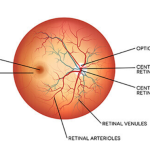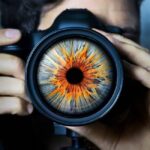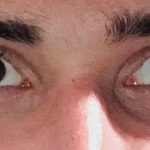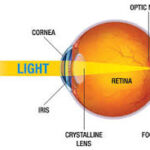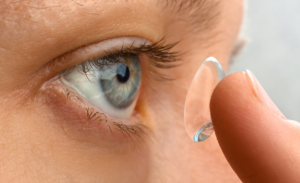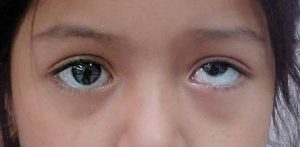Refractive errors are among the most common visual problems affecting individuals across all age
groups. These errors occur when the eye’s optical system fails to focus light precisely on the retina, resulting in blurred vision.
The Eye’s Optical System:-
The eye functions as a complex optical system designed to capture light and focus it on the retina,
where photoreceptor cells convert it into electrical signals. These signals are processed by the brain, allowing us to perceive images. The major components of the eye involved in focusing light include:
1. Cornea: The transparent front part of the eye that provides most of the eye’s refractive power.
2. Lens: The crystalline lens adjusts its shape to fine-tune focus for near and distant objects, a
process known as accommodation.
3. Aqueous Humor and Vitreous Humor: These fluids maintain intraocular pressure and help light pass through the eye.
4. Retina: The inner layer of the eye where light is focused to form images.
For clear vision, light rays entering the eye must converge precisely on the retina. Refractive errors
occur when this process is disrupted.
Classification of Refractive Errors:-
Refractive errors can be broadly classified into four main types:
1. Myopia (Nearsightedness): A condition where distant objects appear blurry because light focuses in front of the retina.
2. Hypermetropia (Farsightedness): A condition where near objects appear blurry due to light focusing behind the retina.
3. Astigmatism: Irregular curvature of the cornea or lens causes light to focus unevenly, resulting in distorted or blurred vision.
4. Presbyopia: Age-related loss of lens elasticity, leading to difficulty focusing on close objects.
Pathophysiology of Refractive Errors:-
Myopia
In myopia, the axial length of the eye is excessively long, or the cornea and lens have increased
refractive power. This causes parallel light rays to focus in front of the retina, leading to blurred distance vision. Myopia is often associated with genetic predisposition and environmental factors like
prolonged near work and limited outdoor activities.
Hypermetropia
Hypermetropia occurs when the axial length of the eye is shorter than normal or the cornea and lens
have reduced refractive power. As a result, light rays focus behind the retina, causing blurred near vision. Accommodation can compensate for hypermetropia to some extent, especially in younger individuals, but prolonged effort can lead to eye strain and
headaches.
Astigmatism
Astigmatism results from an irregular shape of the cornea or lens, causing uneven refraction of light.
Instead of focusing light to a single point on the retina, multiple focal points are created, leading to distorted and blurry vision. Astigmatism can occur in combination with myopia or hypermetropia.
Presbyopia
Presbyopia is an age-related condition caused by the gradual loss of elasticity in the crystalline lens. This reduces the lens’s ability to change shape and focus on near objects. It typically manifests after the age of 40 and is a natural part of the aging process.
Contributing Factors to Refractive Errors:-
1. Genetic Factors: Studies have shown a strong hereditary component, particularly in myopia. Specific genes are linked to axial elongation and refractive power abnormalities.
2. Environmental Factors: Prolonged near work, limited exposure to natural light, and modern lifestyle habits like excessive screen use contribute significantly to the development of refractive errors.
3. Developmental Anomalies: Improper development of the eye during childhood can result in refractive errors.
4. Systemic Diseases: Conditions like diabetes can alter the refractive index of the lens, causing temporary or permanent refractive errors.
Symptoms of Refractive Errors:-
Common symptoms of refractive errors include:
1. Blurred or distorted vision
2. Eye strain or discomfort
3. Headaches, particularly after prolonged near work
4. Difficulty reading or focusing on distant objects
5. Squinting to see clearly
These symptoms can vary depending on the type and severity of the refractive error.
Diagnosis of Refractive Errors:-
Refractive errors are diagnosed through a comprehensive eye examination, which may include:
1. Visual Acuity Test: Determines clarity of vision using a Snellen chart.
2. Retinoscopy: Evaluates the refractive state by observing light reflections in the eye.
3. Refraction Test: Measures the lens power required to correct vision.
4. Keratometry: Assesses the curvature of the cornea, essential for diagnosing astigmatism.
5. Axial Length Measurement: Helps in understanding the role of eye length in refractive errors.
Impact on Quality of Life:
Untreated refractive errors can significantly impact quality of life, particularly in children and older adults. In children, uncorrected refractive errors may lead to learning difficulties and developmental delays. For adults, they can cause visual discomfort and reduce productivity.
Management of Refractive Errors
The primary goal in managing refractive errors is to correct the focus of light onto the retina. This can be achieved through:
1. Spectacles: Glasses with lenses tailored to the individual’s refractive error are the most common and cost-effective solution.
2. Contact Lenses: Provide a wider field of vision and better visual acuity compared to glasses.
3. Refractive Surgery: Procedures like LASIK and PRK reshape the cornea to correct refractive errors.
4. Orthokeratology: Special contact lenses worn overnight reshape the cornea temporarily.
5. Pharmacological Approaches: Atropine eye drops are sometimes used to slow myopia progression in children.
Advances in Refractive Error Management:
Recent advances in technology have improved the diagnosis and treatment of refractive errors. For
example:
Wavefront-guided LASIK: Provides precise corneal reshaping by mapping individual aberrations.
Multifocal Lenses: Offer solutions for presbyopia by allowing focus at multiple distances.
Myopia Control Lenses: Specialized lenses designed to slow the progression of myopia in children.
Preventive Measures:-
While some refractive errors are unavoidable due to genetic factors, certain preventive measures can reduce their impact:
1. Promoting Outdoor Activities: Exposure to natural light has been shown to reduce the risk of developing myopia.
2. Limiting Screen Time: Reducing prolonged use of digital devices can alleviate eye strain.
3. Regular Eye Checkups: Early detection and management of refractive errors can prevent complications.
4. Healthy Lifestyle: Proper nutrition, including vitamins A, C, and E, supports overall eye health.
Conclusion:
Refractive errors are among the most prevalen causes of visual impairment worldwide. Understanding their pathophysiology helps in recognizing the factors that contribute to these conditions and emphasizes the importance of timely diagnosis and management. With advancements in medical science and technology, the burden of refractive errors can be effectively reduced, improving the quality of life for millions of individuals.


